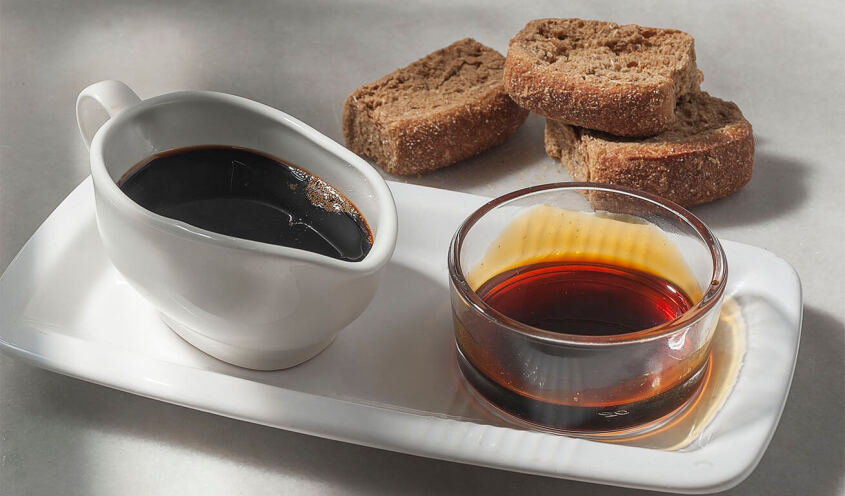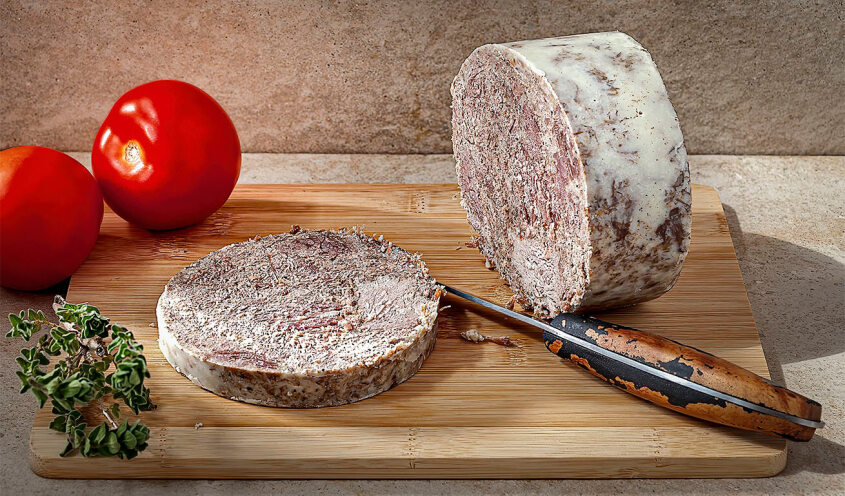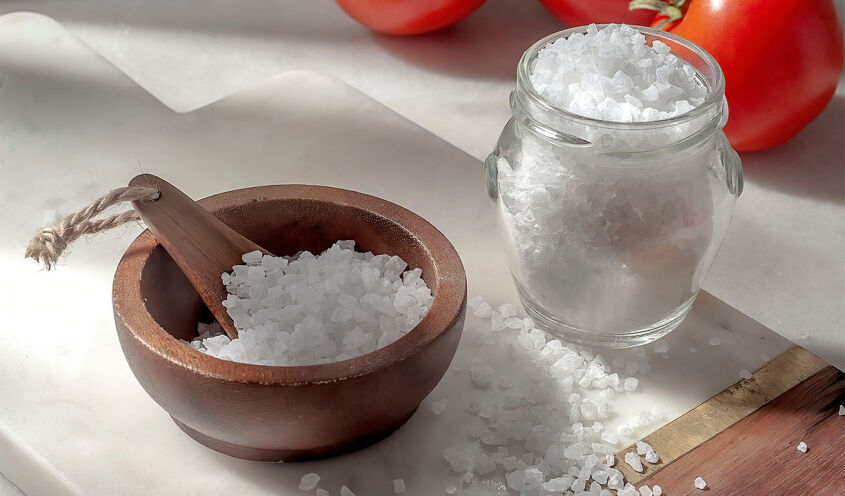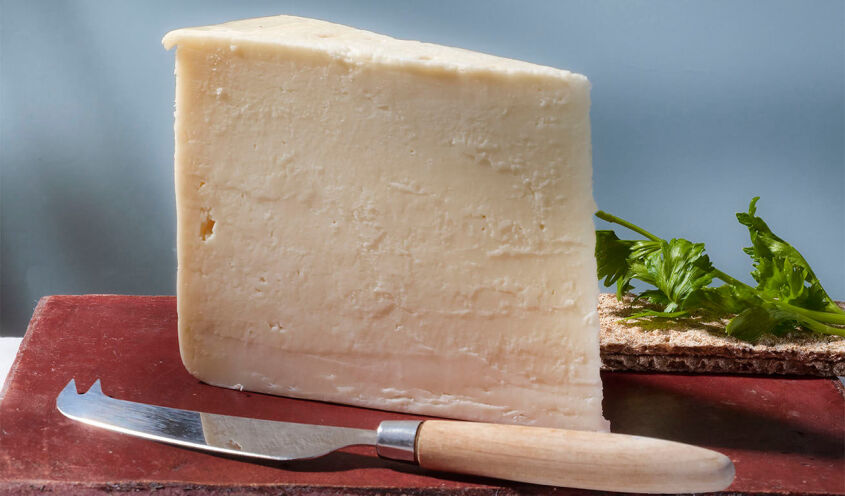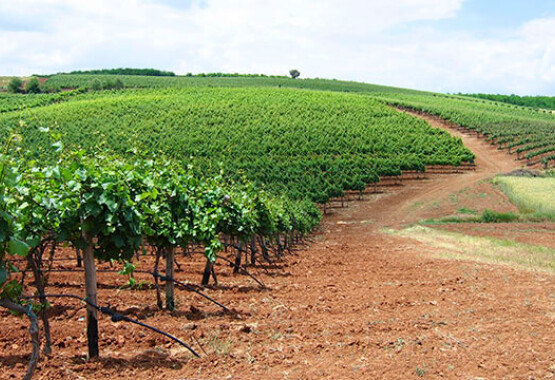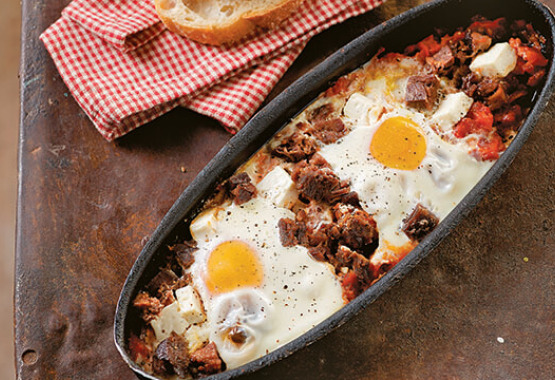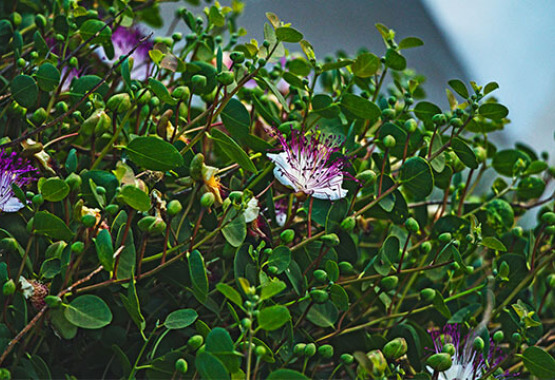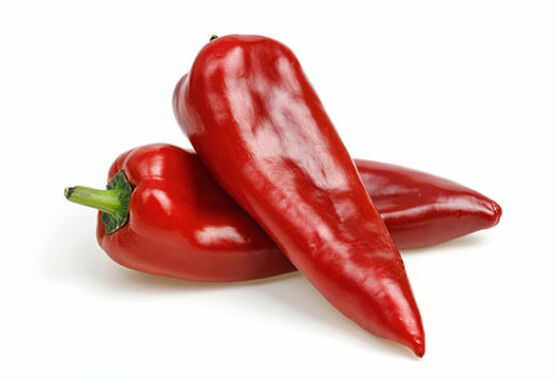
XANTHI
The Kaseri PDO cheese from Xanthi is very popular in northern Greece, and it is produced using the heated cheese mass technique, mainly from sheep milk. Feta PDO and other white cheeses, graviera, kefalotyri, as well as butter, are also produced in the wider area.
Cold meat production is the oldest known way for preserving meat. This area is a cattle farming zone, and cured meats are practically a standard food here. Kavourmas (a word of Turkish origin, where the verb “kavourdizo” - to roast - comes from) is the most popular cold meat in the region of Thrace. It is made from beef, buffalo, lamb or pork. The meat is simmered in large pots for hours until tender and then it is roasted in its fat. The use of spices varies by location and producer; they can be used in significant quantities, or not at all. Standardised kavourmas meats are usually shaped into cylindrical packs, whereas home-made kavourmas cuts are stored in containers and covered in their fat. Petalo (meaning ‘horseshoe’) sausages and spicy soutzouki (freshly made or cured), as well as various types of salami, are on display on the shop windows of the local charcuteries - and they are also exported to several countries. Most of Xanthi's cured meats are halal certified and are made from beef or lamb.
Sesame cultivation was a thriving business until the late ‘70s, but it was abandoned for some decades as there were difficulties in harvesting and in post-harvest handling of the product. Sesame farming has now been reintroduced by the residents of Myrodato village, in the Municipality of Avdira, thanks - also - to the local variety, which yields top quality produce. The new food trends, too, contributed significantly to the resurgence of sesame cultivation, as an emphasis is placed on high nutritional value products. All the while, tahini paste (sesame butter/paste) has become popular and is locally produced, being an essential ingredient in the Thracian cuisine (Thracian = Thrace is the region in which Xanthi belongs), and quite popular in the rest of the country.
Try also the local trachanas, a vegan type of Greek pasta, made entirely out of fresh vegetables and tahini, which is often spicy as hot peppers are usually added. Sweet or sour trachanas, couscous (a type of tiny local pasta), bulgur, petoura (a type of short pasta) and oumats (grated dough, very similar to white trachana) are all produced in small scale local industries.
Black treacle (made from sugarcane) was used regularly as a sweetener by rural families in the 1950s and ‘60s. Later on, its production stopped, only to resurface around 2006 when a women's cooperative in Genisea village started sugarcane cultivation and produced treacle. It now comes in a range of products, mostly spreads, which are made there and in the surrounding villages.
Lately, professional beekeeping is taking its first steps in the area, although amateur beekeepers have been producing fragrant dark-coloured honey from oak, pine, and fir trees, as well as from flowers and herbs (such as oregano and thyme).
Xanthi is one of the most renowned areas in Greece to go mushroom and truffle foraging. The wild mushroom types that are most often found in the area are the porcini (Boletus edulis), Caesar's (Amanita caesarea), golden chanterelle (Cantharellus cibarius), black trumpet or horn of plenty (Craterellus cornucopioides), St. George's mushroom (Calocybe gambosa) and the fairy ring mushroom (Marasmius oreades).
Between February and March, as snow begins to melt on the mountains, you will also encounter the Rhodope crocus (Crocus biflorus subsp. stridii). This top quality saffron variety, with its characteristic aroma, fine taste, and medicinal properties can only be found in Xanthi and Chortiatis, Thessaloniki.
As in other parts of the country, the fishermen of Porto Lagos use fisheries to go fishing for mullets and make roe, which they then sell. In the area many other types of top quality seafood are caught, such as shrimps and crawfish, which are served fresh in the area’s restaurants.
Maize is the second most widely grown crop in the region, after tobacco, while legume growing is gradually being revived, with beans and chickpeas as the most popular crops.
North of Porto Lagos, near Nea Kessani community, there are wetlands where you’ll see a large area with salt marshes. Salt production begins every year from March-April to October. Seawater is pumped from the lagoon into basins, and is then fed into other basins. Their shallow waters, high content of natural elements and the climate conditions lead to salt crystallisation, naturally. The salt is then piled, washed and transferred to open-air warehouses forming huge all-white cone-like piles. It’s a spectacular sight!
Xanthi’s sweets could not be absent from its long list of delicious products. It is only natural that the local tradition in sweet making is a long and impressive one on a land where cultures met and mingled. You must try seker pare, kazan dipi, all kinds of syrupy phyllo sweets with nuts or pistachio, such as baklavadakia, kataifi, saragli, and soutzouk loukoum (sweet made with grape must and walnuts). And count in the chocolate covered sweets such as kariokes, anomala - a chocolate treat with nuts- and nougat creations.
Last but not least, don’t leave without trying a Greek strong flavourful coffee and enjoying dontourma, the tasty local ice cream.
Local Products of Xanthi
The region of Xanthi is renowned for its tobacco farming (basmas variety), which yields top quality tobacco. But this land’s environmental diversity also favours the cultivation of many other agricultural products, with great results.The Kaseri PDO cheese from Xanthi is very popular in northern Greece, and it is produced using the heated cheese mass technique, mainly from sheep milk. Feta PDO and other white cheeses, graviera, kefalotyri, as well as butter, are also produced in the wider area.
Cold meat production is the oldest known way for preserving meat. This area is a cattle farming zone, and cured meats are practically a standard food here. Kavourmas (a word of Turkish origin, where the verb “kavourdizo” - to roast - comes from) is the most popular cold meat in the region of Thrace. It is made from beef, buffalo, lamb or pork. The meat is simmered in large pots for hours until tender and then it is roasted in its fat. The use of spices varies by location and producer; they can be used in significant quantities, or not at all. Standardised kavourmas meats are usually shaped into cylindrical packs, whereas home-made kavourmas cuts are stored in containers and covered in their fat. Petalo (meaning ‘horseshoe’) sausages and spicy soutzouki (freshly made or cured), as well as various types of salami, are on display on the shop windows of the local charcuteries - and they are also exported to several countries. Most of Xanthi's cured meats are halal certified and are made from beef or lamb.
Sesame cultivation was a thriving business until the late ‘70s, but it was abandoned for some decades as there were difficulties in harvesting and in post-harvest handling of the product. Sesame farming has now been reintroduced by the residents of Myrodato village, in the Municipality of Avdira, thanks - also - to the local variety, which yields top quality produce. The new food trends, too, contributed significantly to the resurgence of sesame cultivation, as an emphasis is placed on high nutritional value products. All the while, tahini paste (sesame butter/paste) has become popular and is locally produced, being an essential ingredient in the Thracian cuisine (Thracian = Thrace is the region in which Xanthi belongs), and quite popular in the rest of the country.
Try also the local trachanas, a vegan type of Greek pasta, made entirely out of fresh vegetables and tahini, which is often spicy as hot peppers are usually added. Sweet or sour trachanas, couscous (a type of tiny local pasta), bulgur, petoura (a type of short pasta) and oumats (grated dough, very similar to white trachana) are all produced in small scale local industries.
Black treacle (made from sugarcane) was used regularly as a sweetener by rural families in the 1950s and ‘60s. Later on, its production stopped, only to resurface around 2006 when a women's cooperative in Genisea village started sugarcane cultivation and produced treacle. It now comes in a range of products, mostly spreads, which are made there and in the surrounding villages.
Lately, professional beekeeping is taking its first steps in the area, although amateur beekeepers have been producing fragrant dark-coloured honey from oak, pine, and fir trees, as well as from flowers and herbs (such as oregano and thyme).
Xanthi is one of the most renowned areas in Greece to go mushroom and truffle foraging. The wild mushroom types that are most often found in the area are the porcini (Boletus edulis), Caesar's (Amanita caesarea), golden chanterelle (Cantharellus cibarius), black trumpet or horn of plenty (Craterellus cornucopioides), St. George's mushroom (Calocybe gambosa) and the fairy ring mushroom (Marasmius oreades).
Between February and March, as snow begins to melt on the mountains, you will also encounter the Rhodope crocus (Crocus biflorus subsp. stridii). This top quality saffron variety, with its characteristic aroma, fine taste, and medicinal properties can only be found in Xanthi and Chortiatis, Thessaloniki.
As in other parts of the country, the fishermen of Porto Lagos use fisheries to go fishing for mullets and make roe, which they then sell. In the area many other types of top quality seafood are caught, such as shrimps and crawfish, which are served fresh in the area’s restaurants.
Maize is the second most widely grown crop in the region, after tobacco, while legume growing is gradually being revived, with beans and chickpeas as the most popular crops.
North of Porto Lagos, near Nea Kessani community, there are wetlands where you’ll see a large area with salt marshes. Salt production begins every year from March-April to October. Seawater is pumped from the lagoon into basins, and is then fed into other basins. Their shallow waters, high content of natural elements and the climate conditions lead to salt crystallisation, naturally. The salt is then piled, washed and transferred to open-air warehouses forming huge all-white cone-like piles. It’s a spectacular sight!
Xanthi’s sweets could not be absent from its long list of delicious products. It is only natural that the local tradition in sweet making is a long and impressive one on a land where cultures met and mingled. You must try seker pare, kazan dipi, all kinds of syrupy phyllo sweets with nuts or pistachio, such as baklavadakia, kataifi, saragli, and soutzouk loukoum (sweet made with grape must and walnuts). And count in the chocolate covered sweets such as kariokes, anomala - a chocolate treat with nuts- and nougat creations.
Last but not least, don’t leave without trying a Greek strong flavourful coffee and enjoying dontourma, the tasty local ice cream.
